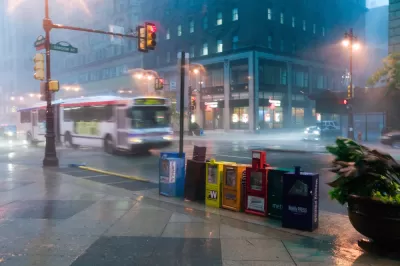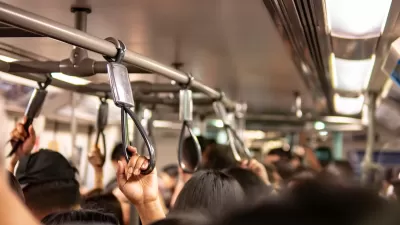The latest data from the American Public Transportation Association reveals the national consequences of many local examples of declining transit use.

"Americans took 9.9 billion public transit trips in 2018, a 2% decrease from 2017, according to a report [pdf] from the American Public Transportation Association (APTA)," reports Katie Pyzyk.
"Bus ridership fell 1.84%, light rail (streetcars, modern trolleys, heritage trolleys) fell 2.98% and heavy rail (subways and elevated trains) fell 2.6%," adds Pyzyk. "Commuter rail was the only mode with a ridership increase at 0.41%."
Pyzyk compares the APTA data to date from the American Community Survey and KPMG and finds similar narratives emerging. The article also includes a survey of some of the steps local transit agencies are taking to deliver more contemporary transit solutions, while also linking to reports that include more recommendations on the steps local and regional transit agencies can take to win back riders.
FULL STORY: APTA: Public transit ridership down in 2018

Study: Maui’s Plan to Convert Vacation Rentals to Long-Term Housing Could Cause Nearly $1 Billion Economic Loss
The plan would reduce visitor accommodation by 25,% resulting in 1,900 jobs lost.

Alabama: Trump Terminates Settlements for Black Communities Harmed By Raw Sewage
Trump deemed the landmark civil rights agreement “illegal DEI and environmental justice policy.”

Why Should We Subsidize Public Transportation?
Many public transit agencies face financial stress due to rising costs, declining fare revenue, and declining subsidies. Transit advocates must provide a strong business case for increasing public transit funding.

Paris Bike Boom Leads to Steep Drop in Air Pollution
The French city’s air quality has improved dramatically in the past 20 years, coinciding with a growth in cycling.

Why Housing Costs More to Build in California Than in Texas
Hard costs like labor and materials combined with ‘soft’ costs such as permitting make building in the San Francisco Bay Area almost three times as costly as in Texas cities.

San Diego County Sees a Rise in Urban Coyotes
San Diego County experiences a rise in urban coyotes, as sightings become prevalent throughout its urban neighbourhoods and surrounding areas.
Urban Design for Planners 1: Software Tools
This six-course series explores essential urban design concepts using open source software and equips planners with the tools they need to participate fully in the urban design process.
Planning for Universal Design
Learn the tools for implementing Universal Design in planning regulations.
Smith Gee Studio
Alamo Area Metropolitan Planning Organization
City of Santa Clarita
Institute for Housing and Urban Development Studies (IHS)
City of Grandview
Harvard GSD Executive Education
Toledo-Lucas County Plan Commissions
Salt Lake City
NYU Wagner Graduate School of Public Service



























